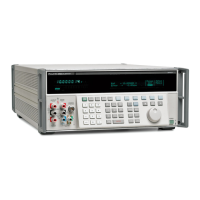Remote Operation
Bus Communication Overview 5
5-55
5-40. Bus Communication Overview
Communication between the controller and the calibrator takes place using commands
established by IEEE-488 standards and commands specifically related to the calibrator.
The commands in Tables 5-1, 5-2, and 5-3 are all the remote commands, both common
and device-dependent. Definitions of the different types of messages used on the IEEE-
488 bus follow.
• Device-Dependent Commands
Device-Dependent commands are messages used to transfer information directly
between the calibrator and the IEEE-488 controller. Some commands cause an action
to take place in the calibrator. Others, called queries in the IEEE standards, ask for
information, and always generate a response message from the instrument. While
message format is governed by IEEE-488 standards, messages themselves can be
unique to the calibrator. For example, device-dependent commands are used to set the
output mode and amplitude, and to switch from standby to operate.
• Common Commands
IEEE standard 488.2 defines common commands, which are used for functions
common to most bus devices. Examples include the command for resetting a device
(*RST) and the query for device identification (*IDN?). Common commands and
queries can be identified easily because they all begin with an asterisk (*).
• Interface Messages
IEEE standards define interface messages, which manage the interface system. Some
of the interface messages have their own control lines, and others are sent over the
data lines by first asserting the control line ATN (Attention). An important thing to
note about interface messages is that unlike device-dependent and common
commands, interface messages are not sent literally (in a. For example, when you
send a device-dependent query to the calibrator, the controller automatically sends
the interface message MTA (My Talk Address).

